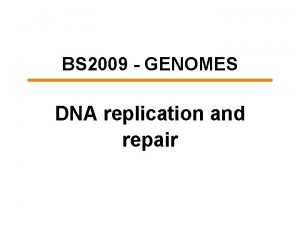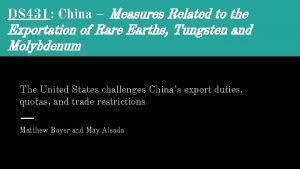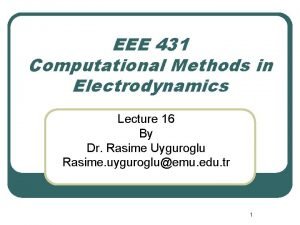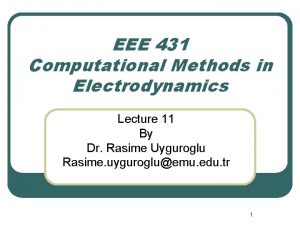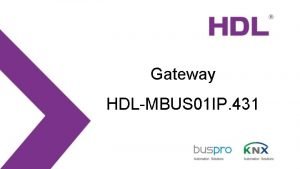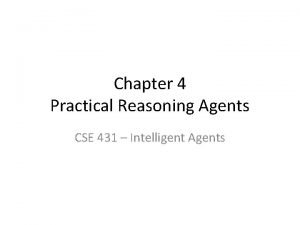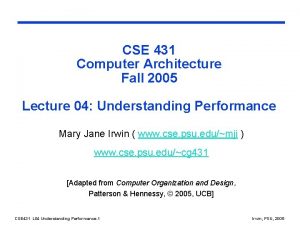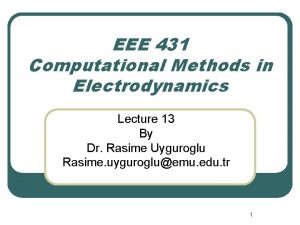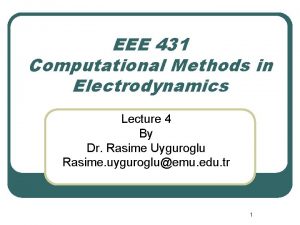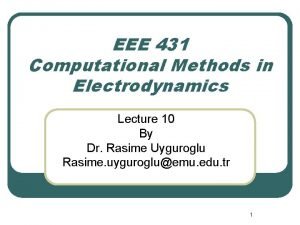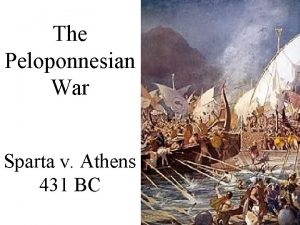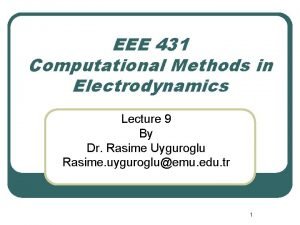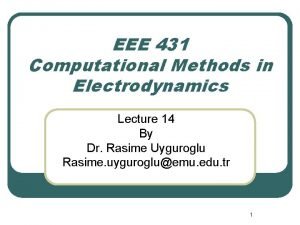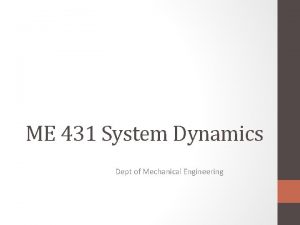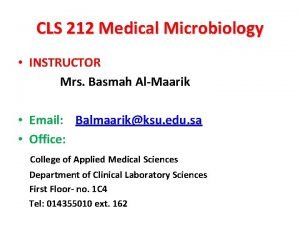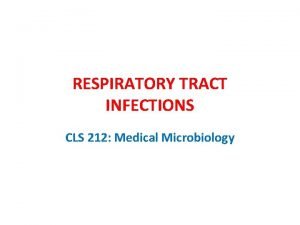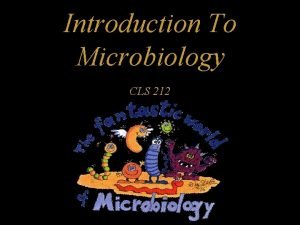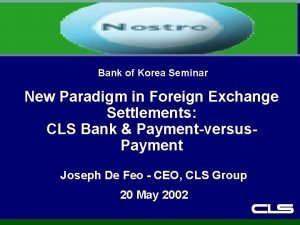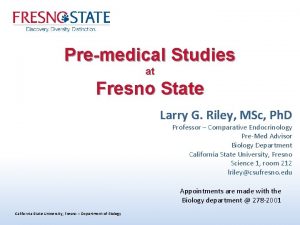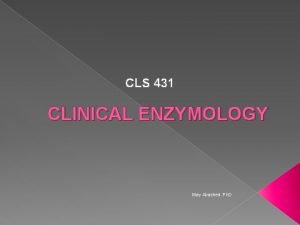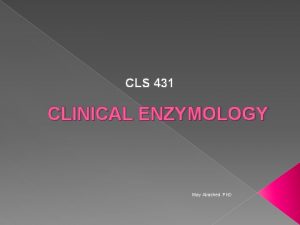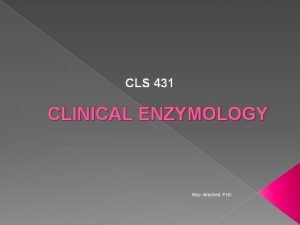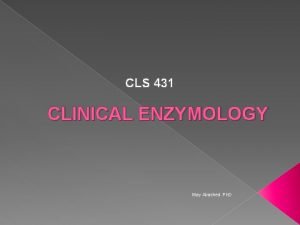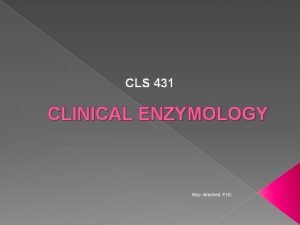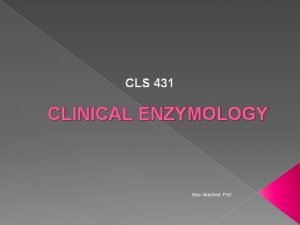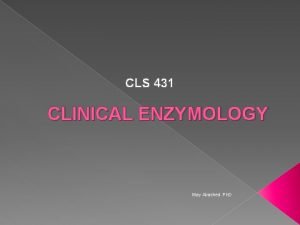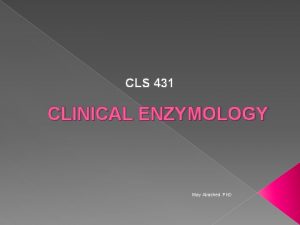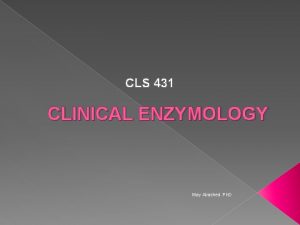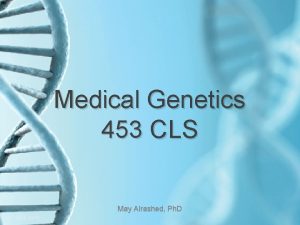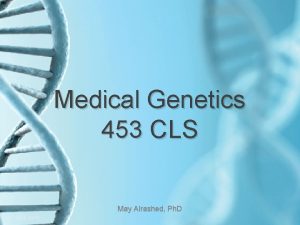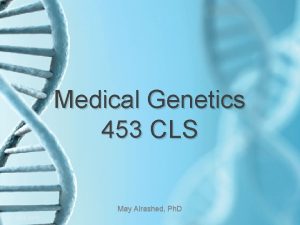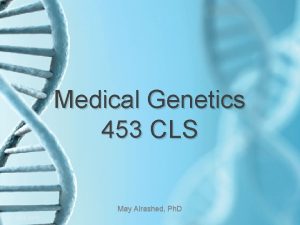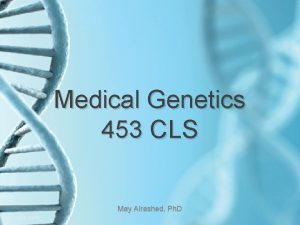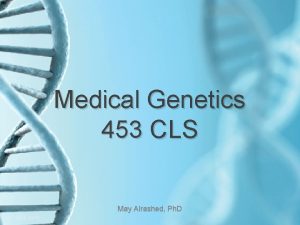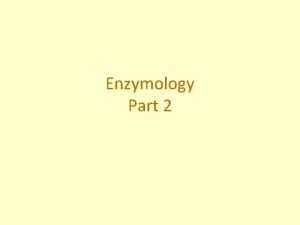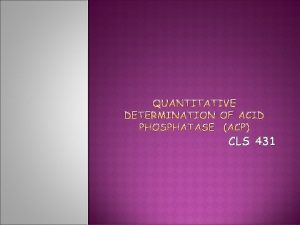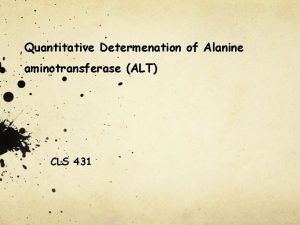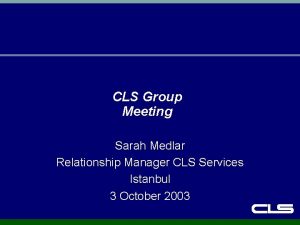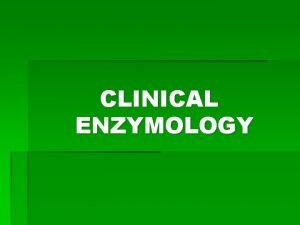CLS 431 CLINICAL ENZYMOLOGY May Alrashed Ph D






























- Slides: 30

CLS 431 CLINICAL ENZYMOLOGY May Alrashed. Ph. D

General properties Ø Enzymes are protein catalyst that increase the velocity of a chemical reaction. Ø Enzymes are not consumed during the reaction they catalyzed. Ø With the exception of catalytic RNA molecules, or ribozymes, enzymes are proteins. Ø In addition to being highly efficient, enzymes are also extremely selective catalysts. May Alrashed. Ph. D

Coenzymes and Cofactors Ø Cofactors can be subdivided into two groups: metals and small organic molecules. Ø Cofactors that are small organic molecules are called coenzymes. Ø Most common cofactor are also metal ions. Ø If tightly bound, the cofactors are called prosthetic groups. Ø Loosely bound Cofactors serve functions similar to those of prosthetic groups but bind in a transient, dissociable manner either to the enzyme or to a substrate. May Alrashed. Ph. D

Coenzymes May Alrashed. Ph. D

Prosthetic group Ø Metals are the most common prosthetic groups. Ø Tightly integrated into the enzyme structure by covalent or non-covalent forces. e. g; › Pyridoxal phosphate › Flavin mononucleotide( FMN) › Flavin adenine dinucleotide(FAD) › Thiamin pyrophosphate (TPP) › Biotin › Metal ions – Co, Cu, Mg, Mn, Zn May Alrashed. Ph. D

Role of metal ions Ø Enzymes that contain tightly bound metal ions are termed – Metalloenzymes. Ø Enzymes that require metal ions as loosely bound cofactors are termed as metal-activated enzymes. Ø Metal ions facilitate Ø Binding and orientation of the substrate. Ø Formation of covalent bonds with reaction intermediates. Ø Interact with substrate to render them more electrophilic or nucleophilic. May Alrashed. Ph. D

May Alrashed. Ph. D

Active Site Ø Active site is a region in the enzyme that binds substrates and cofactors. Ø Takes the form of a cleft or pocket. Ø Takes up a relatively small part of the total volume of an enzyme. Ø Substrates are bound to enzymes by multiple weak attractions. Ø The specificity of binding depends on the precisely defined arrangement of atoms in an active site. Ø The active sites of multimeric enzymes are located at the interface between subunits and recruit residues from more than one monomer. May Alrashed. Ph. D

Active Site Two models have been proposed to explain how an enzyme binds its substrate: Ø lock-and –key model. Ø Induced-fit model. May Alrashed. Ph. D

Lock & Key Model of Enzyme. Substrate Binding In this model, the active site of the unbound enzyme is complementary in shape to the substrate. May Alrashed. Ph. D 10

Induced-Fit Model of Enzyme. Substrate Binding In this model, the enzyme changes shape on substrate binding. Ø The active site forms a shape complementary to the substrate only after the substrate has been bound. Ø May Alrashed. Ph. D

Enzyme Specificity In general, there are four distinct types of specificity: Ø Absolute specificity The enzyme will catalyze only one reaction. Ø Group specificity the enzyme will act only on molecules that have specific functional groups, such as amino, phosphate and methyl groups. Ø Linkage specificity the enzyme will act on a particular type of chemical bond regardless of the rest of the molecular structure. Ø Stereo chemical specificity the enzyme will act on a particular steric or optical isomer. May Alrashed. Ph. D

Absolute specificity Ø Is the highest degree of specificity. Ø The enzyme active site is recognized by a single substrate. Ø Example: Glucokinase catalyzes the conversion of glucose to glucose -6 -phosphate May Alrashed. Ph. D

Group specificity Ø Enzyme active site can recognize many substrates , all belonging to same group of compounds. Example: Ø Trypsin catalyzes the hydrolysis of peptide bond in several proteins. Ø Hexokinases act on six carbon sugars. Ø May Alrashed. Ph. D

Reaction specificity Ø The enzyme catalyzes only one type of reaction Example: Ø Oxidoreductases catalyze oxidation –reduction reactions Ø May Alrashed. Ph. D

Optical specificity Enzyme is stereospecific. Ø Is capable to differentiate between L- and Disomers of a compound. Ø Example: Ø › L amino acid oxidase acts only on L-amino acid. › α-glycosidase acts only on α-glycosidic bond which are present in starch and glycogen. › β-glycosidase acts only on β -glycosidic bond that are present in cellulose. (think)*** May Alrashed. Ph. D

Mechanism of Action of Enzymes How do enzymes catalyze? The basic enzymatic reaction can be represented as follows ES complex EX complex http: //www. wiley. com/college/pratt/0471393878/instructor/animations/enzyme_kinetics/index. html May Alrashed. Ph. D

How do enzymes increase the rate of reaction? Ø Enzymes increase reaction rates by decreasing the amount of energy required to form a complex of reactants that is competent to produce reaction products. Ø This complex is known as the activated state or transition state complex for the reaction. Ø Enzymes and other catalysts accelerate reactions by lowering the energy of the transition state. May Alrashed. Ph. D

Stabilization of the Transition State Ø The catalytic role of an enzyme is to reduce the energy barrier between substrate and transition state. Ø This is accomplished through the formation of an enzyme-substrate complex (ES). Ø This complex is converted to product by passing through a transition state (EX‡). Ø The energy of EX is lower than for substrate. Therefore, this decrease in energy partially explains the enzymes ability to accelerate the reaction rate. May Alrashed. Ph. D

May Alrashed. Ph. D

Mechanism of Action of Enzymes The mechanism of action of enzymes can be explained by two perspectives Ø Thermodynamic changes: The enzymes provide an alternate, energetically favorable reaction pathway different from the uncatalyzed reaction. Ø Processes at the active site: Describes how the active site chemically facilitates catalysis. May Alrashed. Ph. D

1) Thermodynamic changes Ø All chemical reactions have an energy barrier separating the reactants and the products. This barrier, called the free energy of activation, activation which is the energy difference between that of the reactants and a high-energy intermediate that occurs during the formation of product. Ø Enzymes accelerate reactions by lowering the free energy of activation Ø Enzymes do this by binding the transition state of the reaction better than the substrate Ø The lower activation energy means that more molecules have the required energy to reach the transition state. Ø May Alrashed. Ph. D

This figure shows the changes in energy during the conversion of a molecule of reactant A to product B as it proceeds through the transition state (high-energy intermediate), T*: A & T* B May Alrashed. Ph. D

Energy changes occurring during the reaction 1. Free energy of activation: The peak of energy is the difference in free energy between the reactant and T* (transition state). 2. Rate of reaction: Ø For molecules to react, they must contain sufficient energy to overcome the energy barrier of the transition state. Ø In the absence of an enzyme, only a small proportion of a population of molecules may possess enough energy to achieve the transition state between reactant and product. Ø The rate of reaction is determined by the number of such energized molecules. Ø In general, the lower the free energy of activation, the more molecules have sufficient energy to pass through the transition state, and, thus, the faster the rate of the reaction. May Alrashed. Ph. D

3. Alternate reaction pathway: Ø An enzyme allows a reaction to proceed rapidly under conditions prevailing in the cell by providing an alternate reaction pathway with a lower free energy of activation (see Figure). Ø The enzyme does not change the free energies of the reactants or products and, therefore, does not change the equilibrium of the reaction. May Alrashed. Ph. D

Effect of a Catalyst (enzymes) on Activation Energy May Alrashed. Ph. D

2) Processes at the active site Ø The combination formed by an enzyme and its substrates is called the enzyme–substrate complex. Ø When two substrates and one enzyme are involved, the complex is called a ternary complex; One substrate and one enzyme are called a binary complex. Ø The substrates are attracted to the active site by electrostatic and hydrophobic forces, which are called noncovalent bonds because they are physical attractions and not chemical bonds Ø May Alrashed. Ph. D

2) Processes at the active site Catalysis by proximity When an enzyme binds substrate molecules at its active site, it creates a region of high local substrate concentration. Enzyme-substrate interactions orient reactive groups and bring them into proximity with one another. 2. Acid base catalysis the ionizable functional groups of aminoacyl side chains of prosthetic groups contribute to catalysis by acting as acids or bases 1. May Alrashed. Ph. D

3. Catalysis by strain Enzymes that catalyze the lytic reactions involve breaking a covalent bond typically bind their substrates in a configuration slightly unfavorable for the bond that will undergo cleavage. 3. Covalent Catalysis Involves the formation of a covalent bond between the enzyme and one or more substrates which introduces a new reaction pathway whose activation energy is lower May Alrashed. Ph. D

Enzyme Catalysis- overview May Alrashed. Ph. D
 Enzymology of replication
Enzymology of replication Ds 431
Ds 431 Eee 431
Eee 431 Eee 431
Eee 431 Hdl buspro setup tool 2
Hdl buspro setup tool 2 Cse 431
Cse 431 Cse 431
Cse 431 Eee 431
Eee 431 Cs 431
Cs 431 Eee 431
Eee 431 431 bc
431 bc Eee 431
Eee 431 Bio 431
Bio 431 431 bce
431 bce Eee 431
Eee 431 Eee 431
Eee 431 Me 431
Me 431 Dibels nwf cls
Dibels nwf cls Cls in c#
Cls in c# Cls 212
Cls 212 Cal state la cls program
Cal state la cls program Cls beam status
Cls beam status Cls 212
Cls 212 Dot net architecture
Dot net architecture Cls 212
Cls 212 Cls certification army
Cls certification army Sfsu cls
Sfsu cls Cls settlement timeline
Cls settlement timeline Numarul substantivelor clasa 3
Numarul substantivelor clasa 3 Fresno state cls program
Fresno state cls program Sf state cls program
Sf state cls program
